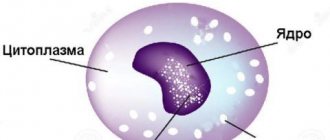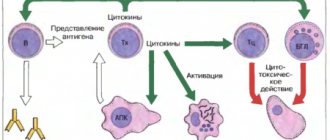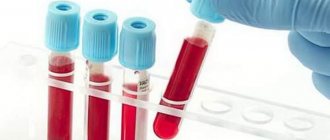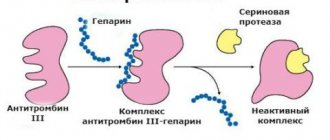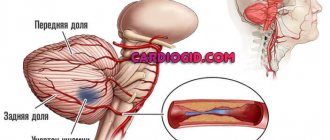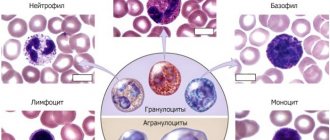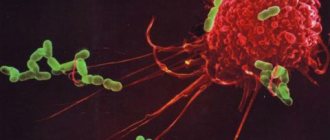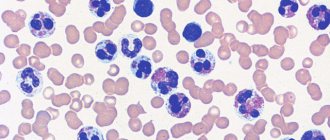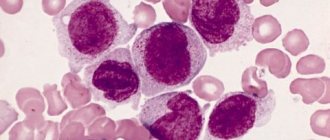Is your baby sick and has a blood test been prescribed? Why do the results show elevated monocytes in the child? What does this mean and what diseases is it a sign of? In what cases are these numbers a natural phenomenon, and when are they a cause for concern?
- The child has elevated monocytes and eosinophils
The role of monocytes in the children's body
Monocytes are one of the white blood cells. Unlike the same neutrophils, eosinophils and basophils, they do not contain granules, which is why they are called agranulocytes. The counting of cells in a blood test is based on this fact. Monocytes serve as short-lived cells (this period usually ranges from one and a half to three days). Granulocytes, by comparison, usually live from one hundred to three hundred days.
What does it mean when lymphocytes are low and monocytes are high in a child? Let's figure it out.
Monocytes are formed in the bone marrow and then enter peripheral tissue. In it, these cells differentiate, as a rule, into macrophages. To perform their physiological function, they require the presence of oxygen, since it is necessary for the production of energy. Under anaerobic conditions they can also function normally, but less efficiently. Usually this happens in foci of purulent inflammation.
Receptors that are located on the surface of monocyte macrophage cells recognize damaged cells along with microbes, pathological mediators, and so on. This serves as a trigger stimulus that activates the monocyte macrophage unit. This may be accompanied by the formation of hydrogen peroxide, superoxide ions, hydroxide radicals, and the like. All these components provide the body's immunity.
Is it dangerous when a child’s monocytes are low?
Diagnostic value of simultaneous deviations from the norm of other blood parameters
When deciphering the CBC, it is important to look at the significance of not only elevated macrophages, but also other cells, not only those related to leukocytes:
The most common blood cell reactions are:
- Increased lymphocytes and macrophages can be detected when exposed to a viral infection (influenza, measles, chickenpox, respiratory disease), and decreased lymphocytes will indicate a malfunction in the immune system. Lymphocytes are blood cells that are part of white blood cells and are produced by the lymph nodes and thymus gland. They are responsible for cellular immunity. When a child’s lymphocytes and monocytes are elevated during the period of recovery from an infectious disease, there is no need to worry about the outcome of the disease. This means that the child will cope with the disease.
- Increased phagocytes and eosinophils indicate allergic reactions (bronchial asthma, atopic dermatitis) and helminthiasis (ascariasis, giardiasis). Sometimes they indicate lymphomas and leukemias. Eosinophils are granulocyte cells produced by the bone marrow. Their function is to fight pathological organisms. The most common reason why a child has elevated eosinophils is helminthiasis and allergic diseases. Separately, congenital eosinophilia is distinguished.
- If a child has elevated monocytes and basophils, this may indicate the presence of an allergy or autoimmune disease. Basophils are the smallest cells of the immune system. Their main function is the destruction of foreign viruses, microbes and bacteria. Basophils are the first of all cells to be directed towards inflammation.
- Elevated monocytes + neutrophils in a child indicate the appearance of a bacterial infection. In such cases, the level of lymphocytes decreases, and the sick baby has a high fever, cough, rhinitis with thick mucus; upon listening, the doctor diagnoses wheezing in the lungs. Neutrophil granulocytes are responsible for the process of phagocytosis - the capture and consumption of foreign particles. Their biggest role is to protect the child’s body from fungal and bacterial infections.
- Elevated platelets and histiocytes may indicate infectious diseases (meningitis, toxoplasmosis). Platelets are not part of the leukocyte formula, but are a cellular element of the blood. Their function is to act as a kind of “blockage” at the site of the damaged vessel. Elevated platelets in a blood test are a reason to prescribe additional examinations.
- Low platelets and histiocytes are an alarming sign that there is a problem with hematopoiesis at the bone marrow level.
Monocytes and ESR
Red blood cells are blood cells saturated with hemoglobin that carry oxygen throughout the body. The erythrocyte sedimentation rate (ESR) test is accepted as the international standard for performing a general blood test. This indicator does not exist separately from others. Monocytes and ESR in humans are related in the same way as all blood components are related to each other. The normal ESR level in a child changes with age. The normal ESR rate for a baby at birth is approximately 20 times less than for a one-month-old baby. An elevated ESR along with an increase in phagocytes may indicate an infection.
Actions to take when monocytes are elevated in the blood
Monocytosis is not actually a separate disease in its own right, but it is a symptom of the presence of the disease. To treat the pathology, it is important to understand the reason why an increased level of monocytes was found in a child. The treatment must be carried out by a doctor! In the case of infectious diseases, these will probably be medications. Oncological diseases require more intensive examinations and treatment measures.
Elevated monocytes in children: should you worry?
Rate this post
Consequences of relegation
Monocytes in a child’s body perform a variety of functions and their reduction is fraught with certain cavities:
- Weak fight against pathogenic bacteria.
- Insufficient regulation of the immune response and inflammatory reactions.
- Insufficient control over the restoration of damaged tissue.
- Weak antitumor effect.
- Dysregulation of bone marrow functions to produce all blood cells.
- Poor digestion of defective cells.
Place of monocytes in the leukocyte formula
In the process of deciphering a blood test, an important role is played by the leukocyte formula . Let’s figure out what it means and what processes in the baby’s body it is a reflection of. So, the leukogram consists of 2 groups of indicators:
- Granulocytes - eosinophils, neutrophils, basophils.
- Agranulocytes – lymphocytes, monocytes.
The percentage of these values is the leukocyte formula. In diseases, the percentage of certain cells changes, and a shift of the leukogram to the right or left can be observed.
Among all peripheral blood cells, monocytes are characterized by the highest activity of phagocytosis. They are produced by the bone marrow, remain in the blood for 2-3 days, then mature in the tissues, turning into histiocytes.
Monocyte norms
How is it determined that a child’s monocytes are low? What are the norms?
The number of monocytes in the blood is constant throughout life. Therefore, the norms of such cells in adults and small patients are practically the same. The normative upper limit of their number is eleven percent in relation to other leukocytes. A decrease in monocytes of less than three percent is called monocytopenia, and an increase of more than eleven is called monocytosis.
It happens that lymphocytes are low and monocytes are high in a child. More on this below.
However, it is necessary to distinguish between absolute and relative monocytopenia. In the absolute form, we are talking about the overall value of cells of a given type, that is, this parameter is expressed in the number of monocytes per liter. Its normative limit is 0.09 ∙ 10⁹/l. A decrease in monocytes below this value is absolute monocytopenia, and an increase of more than 0.6 ∙ 10⁹/l is monocytosis.
Thus, the concept of absolute and relative monocytopenia coincides only when the percentage and total number of monocytic and macrophage cells decreases. They cannot coincide when there is a multidirectional decrease in monocytes. Typically, such an imbalance in the leukoformula may indicate an extremely serious condition in the child, requiring a longer examination and prompt initiation of therapy. Next, we’ll talk about the main factors that influence the decrease in the blood indicator in question in the child’s body.
Why are there low monocytes in a child?
Normal indicators
Leukocytes provide an immune barrier against infection, inflammation, and the growth of a malignant tumor. Immune functions are carried out by the most numerous populations of white blood cells:
- neutrophils (NEU);
- lymphocytes (LYM).
The concentration of leukocytes is measured as a percentage. The indicators reflect the amount of total leukocytes that accounts for each cell group.
Important information: Consequences for the donor of platelet donation and how to donate
The leukocyte norm in children differs from the norm in adults. The newborn has elevated white blood cells due to a high concentration of neutrophils. Their LYM levels, compared to the norm in adults, are reduced.
After 7 days, the parameters of the LYM and NEU cells in the newborn are equalized. This balance is called leukocyte crossover. From 7 days to 5 years, the LYM value should normally be greater than neutrophils.
This distinguishes the leukocyte proportions in children and adults. Parents, not knowing this feature, often get scared and begin to worry.
At 5-6 years, the LYM analysis and the number of NEUs again become approximately the same, as was observed at 7 days in newborns. This phenomenon is called second leukocyte crossover and reflects normal immune development.
Neutrophils
Neutrophilic white blood cells increase during inflammation caused by bacterial infections. There are 2 groups of neutrophils present in the blood:
- immature rod forms (NEUp);
- mature segmented forms (NEUc).
An informative indicator is the number of segmented NEUc cells.
Normal NEUc in children depending on age (in%):
- 1-2 — 28-48;
- 2-3 — 32-55;
- 3-6 — 32-55;
- 6-9 — 38-58;
- 9-12 — 43-60.
Lymphocytes
The group is responsible for the production of antibodies to foreign proteins. A significant increase in these blood elements is observed in viral diseases.
Normal lymphocyte counts in children depending on age (in%):
- 1-2 — 37-60;
- 2-3 — 33-55;
- 3-6 — 33-55;
- 6-9 — 30-50;
- 9-12 — 30-46.
Main causative declines in children
Cases when a child's monocytes are below normal are called monocytopenia in medicine. This is usually observed in the following conditions:
- Against the background of sepsis, there are low monocytes in the blood of a child, which is a serious process caused by the presence of pathogenic microbes in the body that circulate in the blood and enter various organs.
- The development of leukemia is a pathological proliferation of cells in the brain that simply do not have time to undergo differentiation, and therefore they do not perform their proper functions. They cause harm to the body (we are talking about tumors of the hematopoietic system). Immature blood cells can affect various organs.
Now let's look at the symptoms of the described deviation.
Norms for children
In babies, white blood cell levels change. Let's look at what monocyte numbers (normal) are in children of different age categories. This is essential for correct diagnosis.
| Age | % content of the total number of leukocytes |
| Newborns | 3-12% |
| Infants 2 weeks | 5-15% |
| Babies from 2 weeks to a year | 4-10% |
| Babies from 1 year to 2 years | 3-10% |
| Children from 2 to 5 years old | 3-9% |
| Children from 5 to 16 years old | 3-9% |
| Children from 16 to 18 years old | 8% |
Symptoms
How does a condition manifest when monocytes in a child’s blood are low?
As a rule, these elements decrease against the background of an increase in other leukocytes. In this regard, monocytopenia occurs in acute lymphoblastic or myeloblastic leukemia. However, this symptom is not a specific sign, and only on its basis the diagnosis is never made. This is an accompanying manifestation that may or may not exist. Symptoms may also be as follows:
- The appearance of anemia associated with suppression of bone marrow functions.
- The development of anemia arising from a deficiency of B12 or folic acid.
- The appearance of systemic lupus, which is an autoimmune disease in which skin lesions are observed, the kidneys, and sometimes other organs are affected.
It is important to note that conditions in which monocytes are reduced in a child are extremely serious. They indicate severe leukemic changes. Therefore, the level of these elements in the blood is a very important criterion, which indicates the adequacy of therapy. A zero monocyte count can even be life-threatening and is incompatible with it. Such cells are an important indicator of the child’s immunity.
Causes of increased monocytes in the blood
A slight increase in monocytes should not cause great concern. Low relative monocytosis appears after infectious diseases, injuries or bruises, teething or treatment with antibiotics and other drugs.
A significant increase in the number of monocytes is observed in the following pathological conditions:
1. Parasitosis - infection with roundworms, pinworms or other parasites causes a strong increase in monocytes in a general blood test. This is characterized by a general weight loss of the child against the background of normal or increased appetite, fatigue, decreased performance, headaches, abdominal pain, sleep disturbances, irritability and tearfulness. To confirm the diagnosis, it is necessary to test feces for parasite eggs;
2. Infectious and viral diseases - any colds, intestinal and other infections cause relative monocytosis and a general increase in the number of leukocytes;
3. Fungal infections - mycoses, candidiasis and other fungal infections of the skin and mucous membranes cause monocytosis. Sometimes an increase in the number of monocytes becomes the first sign of fungal infection;
4. Systemic diseases - a persistent increase in the number of monocytes against the background of other changes in the blood test can occur with diseases of connective tissue and internal organs such as systemic lupus erythematosus, rheumatoid arthritis, polyarthritis and others. They are characterized by simultaneous damage to joints and internal organs;
5. Granulomatosis - diseases accompanied by the formation in the body of granulomas, areas of inflammation limited by the capsule, are also accompanied by a persistent increase in the number of monocytes. Changes in the leukocyte formula occur with tuberculosis, syphilis, brucellosis, sarcoidosis and other similar diseases;
6. Blood diseases - absolute monocytosis occurs when there are disorders of hematopoietic processes in the spinal cord - leukemia, mononucleosis, lymphogranulomatosis and other blood diseases;
7. Poisoning – when phosphorus or tetrachloroethane enters the body, severe intoxication of the body occurs, accompanied by monocytosis.
Any deviation from the norm in blood tests necessarily requires a visit to a doctor and additional research, especially with monocytosis in a child, since in childhood the risk of parasitic infections or blood diseases is several times higher.
Lymphocytes are low in the child, monocytes are high
In this case, the reasons may be:
- Presence of protein deficiency in the diet.
- Insufficient functioning of the bone marrow.
- Negative effects of radiation energy.
- The use of drugs that have a depressing effect on hematopoiesis.
- Presence of immune deficiency.
- Development of infection with viruses that exhibit tropism for lymphocytes. In this case we are talking about HIV, polio, measles and chickenpox, and so on.
- The occurrence of systemic inflammation of the connective tissue, in which antibodies against lymphocytes are formed.
- The influence of stressful conditions.
- An increase in hormones in the blood that are secreted by the adrenal cortex.
Reduced lymphocytes and increased monocytes in a child should not go unnoticed.
Basophils and monocytes are increased in an adult
The main role of basophils is to prevent harmful bacteria and infections from entering the body. These cells help heal wounds and cuts, forming a protective crust (through lymphocytes). During the healing process, white cells are destroyed, itching and irritation appear, and the tissue near the wound may swell. However, that's not all. Basophils perform several additional functions:
- They contain heparin (an active substance that thins the blood), which prevents blood clotting.
- Prevents the occurrence of allergic reactions and anaphylactic shock. When the immune system is exposed to increased exposure to antigens, white cells release histamine and promote the production of special agents (antibodies) called immunoglobulins. This helps relieve itching on the skin.
- Kill parasites, such as ticks.
- Fight toxins.
What does it mean if a child’s monocytes are increased?
Like most blood cells, monocytes produce bone marrow. Mature monocytes remain in the blood for about 70 hours. Then they migrate to the liver, spleen, lymph nodes, and body tissues.
Monocytes destroy pathogens, dead cells and tissues, and foreign formations, for which they are called “janitors,” “cleaners,” or “eater cells.”
These cells are able to neutralize pathogenic formations that are many times larger than monocytes.
The number of monocytes in an adult is normally 3-11% of the total number of leukocytes. Since the children's body needs enhanced protection, wise nature took care of a higher content of monocytes in their blood:
- Their number reaches 12% in newborns;
- 4-10% – monocyte content in one-year-old children;
- 3-9% is the norm for teenagers.
With age, the percentage of monocytes may decrease to one.
Causes of monocytosis
If a general blood test shows that a child has elevated monocytes, this is not always a cause for parental concern.
When a baby is teething, he has recently suffered from any infectious disease, has been injured or seriously bruised, the body receives a signal that increased production of wiper cells is required.
In such cases, the content of monocytes in the blood may increase by 10 percent of normal.
If the increased content of monocytes (monocytosis) is accompanied by some additional manifestations of ill health, then we can judge the presence of pathological processes in the body. Most often we are talking about fungal and infectious diseases: malaria, brucellosis, toxoplasmosis, congenital syphilis.
Elevated monocytes in a child can also occur in such serious diseases as leukemia, lymphogranulomatosis, sepsis, systemic lupus erythematosus, infective endocarditis, rheumatoid arthritis, as well as tuberculosis, enteritis and ulcerative colitis. Monocytosis is also observed in cases of phosphorus or tetrachloroethane poisoning.
An increased content of monocytes in a child’s blood is always considered in the context of the total number of leukocytes.
There are relative monocytosis (normal leukocyte content, but the proportion of monocytes in them is increased) and absolute (increased absolute level).
Typically, absolute monocytosis is characteristic of adults; in children it is recorded only during extensive purulent processes in the body.
If a general blood test reveals an increased content of monocytes, then a detailed analysis is prescribed, which helps the doctor determine the exact reason why the number of monocytes in the child has increased.
Monocytes are the largest cells found in the human body. If monocytes in the blood of a child or an adult are increased or decreased, then this is necessarily fraught with some diseases. These cells belong to the group of leukocytes.
Their increased level indicates not only that the body has been exposed to some kind of disease, but also that the body itself is still capable of fighting viruses and infection.
If, when taking a general blood test, the level of monocytes is higher than normal, then additional tests will be required.
Properties of monocytes
Since it is monocytes that are responsible for the proper functioning of the immune system and are able to recognize and destroy all harmful and infected cells, this number also includes cancer cells.
They originate in the human bone marrow, then, half mature, move into the blood. But they can stay there only for 3-4 days, then they can be found in the spleen and liver.
Monocytes are also responsible for normalizing blood clotting and preventing the formation of clots and thrombophlebitis.
By cleansing the body of germs and infections, such leukocytes help cells recover from various diseases and damage.
One neutrophil is known to kill 25 to 35 bacteria, while a monocyte can kill about 100 bacteria at a time. The maximum activity of these cells is observed in the most acidic environment - in such an environment they seem to wake up and come to life, while other leukocytes do not have this opportunity. A disease in which monocytes are elevated is called monocytosis.
Causes of pathology
If a child's monocytes are elevated, this is not always the cause of the disease; it is often due to the fact that teeth are being cut. Parents should start to worry if, in addition to teething, other symptoms begin to appear, signaling that the child is starting to get sick.
The reasons why monocytes in a child’s blood are elevated may be the following:
- Congenital pathologies of the body - syphilis, hepatitis, fungus. Various infectious diseases - severe colds, pneumonia, measles.
- Today, tuberculosis is very rare in childhood, but it should not be completely excluded from the list. Chemical poisoning or burns of internal organs may also be the cause.
- The presence of worms and roundworms can also cause increased monocytes in a child’s blood.
- Any surgical intervention. Various injuries to the body - bruises, blows, fractures.
- The emergence of cancer - leukemia.
The fact that the child has some kind of pathology can be additionally confirmed by other tests where the norms for the content of elements are exceeded. Such tests include: ESR, red blood cells, platelets, lymphocytes and basophils.
In cases where red blood cells are elevated, we can talk about heart disease, lung disease and some inflammatory processes occurring in the body. If, according to test results, lymphocytes and monocytes are higher than normal, this indicates the presence of a tumor process.
An overestimation of the platelet norm is associated with inflammatory and infectious diseases, the initial stage of tuberculosis, the period after surgery, and anemia. A high ESR indicates severe anemia, the presence of chronic diseases and kidney disease. A high level of basophils may indicate the presence of iron deficiency in the body.
Monocyte level in children.
These cells in a person’s blood can change with age:
- in newborns, the normal level of these cells is 2-11%;
- in a child from 2 weeks to a year, the norm is 5-10%;
- from one to 2 years the norm is 3-10%;
- from 2 to 5 years the norm is 3-9%;
- from 5 years to 16 the normal level is 2-9%;
- With age, the level of leukocytes in the blood can reach 1 percent equivalent.
Most analyzes are calculated as percentages. But for monocytes, not only the relative percentage ratio is important, but also the absolute one. This value determines the exact number of cells found in one liter of blood. This value is abbreviated as abs.
In children, the normal number of monocytes is 0.07-1.2 x 109/l.
their absolute quantity must be found out if there is a suspicion of a malfunction of the bone marrow. In other cases, you can only get by with a general blood test.
First of all, after a blood test has been taken and it has become obvious that the number of monocytes is increased, you need to determine the cause of the increase in cells and find out whether there is cause for concern or not.
If exceeding the norm is a consequence of a recent operation or injury, then nothing needs to be done, the body will cope on its own and after some time the level of these cells will return to normal. If the cause of monocytosis is any pathology, then you should first determine what kind of disease it is, and then begin to treat it.
Both in the presence of the disease and in its absence, but with an increased number of monocytes, it is recommended to use the drug Transfer Factor. The drug is absolutely safe for both adults and children. This remedy has an effect on the entire immune system, favorably affecting its functioning.
The norm of basophils in the blood
Testing done in a clinical setting is the only way to know if basophils are higher than normal.
Often, an increase in the number of white cells does not have clear symptoms, so doctors rarely refer the patient for testing. However, the cause of the increase can be identified by taking a general blood test.
What is the basophil norm? Taking into account individual characteristics, in the human body there should be from 1 to 300 per μl (microliter).
Basophils make up only 0.5% of all leukocytes. In addition to this type of cells, the following can be found in the blood:
- Neutrophils. This is the largest group of leukocytes. They cope with severe infectious conditions.
- Eosinophils. Helps fight parasitic infections.
- Lymphocytes are part of the immune system and prevent the invasion of pathogens (bacteria, viruses).
- Monocytes fight antigens, infections in the bloodstream, help restore damaged tissue, and destroy cancer cells.
Reasons for increased basophils in the blood
The presence of a normal level of white cells helps maintain health and is involved in protection against infections. If basophils in the blood are elevated, this may indicate the development of dangerous diseases. One of them is bone marrow cancer, which leads to the production of huge numbers of granulocytes.
- acute viral infections;
- hives;
- consequence of splenectomy (surgery);
- myxedema;
- entry of an antigen into the blood (allergy);
- iron deficiency;
- ulcerative colitis;
- systemic mastocytosis;
- malignant tumors;
- myeloproliferative disorders (chronic myeloid leukemia, myelofibrosis);
- polycythemia.
In an adult
Basophils, together with other subpopulations of cells (eosinophils, lymphocytes, monocytes) can lead to an increase in the number of leukocytes in the blood and the development of cancer. What other reasons exist for the increase in white cells in the body of an adult:
- improper functioning of the thyroid gland;
- liver and kidney diseases;
- low progesterone levels;
- collagen vascular disease;
- pathology of the spleen;
- asthma;
- allergic reactions, hypersensitivity to certain drugs;
- diabetes;
- viral, bacterial infections.
Sometimes an increase in basophils in the blood can be observed during therapy and taking certain medications. When receiving a small dose of radiation (X-ray), the level of white cells increases, but this is quite normal. The recovery period after an infectious disease is also characterized by an increase in white blood cells. This suggests that the body is strenuously fighting for health.
What does it mean when monocytes and lymphocytes are elevated at the same time?
Against the background of the penetration of foreign agents into the body, a triggering reaction of the immune response occurs. To achieve this, the number of specific blood cells increases compared to the normal state. The protection of the immune system ensures the constancy of the internal environment of the child’s body. This is achieved through the production of special substances against specific pathogens (antibodies) or the direct destruction of a foreign agent. Thus, an increase in the level of lymphocytes and monocytes in the child’s bloodstream occurs against the background of activation of his immune system.
What are monocytes and how are they formed?
Monocytes are a type of agranulocytic leukocyte (white blood cell). This is the largest element of the peripheral blood flow - its diameter is 18-20 microns. The oval-shaped cell contains one eccentrically located polymorphic bean-shaped nucleus
Intense coloring of the nucleus makes it possible to distinguish a monocyte from a lymphocyte, which is extremely important in laboratory assessment of blood parameters
In a healthy body, monocytes make up 3 to 11% of all white blood cells. These elements are also found in large quantities in other tissues:
- liver;
- spleen;
- Bone marrow;
- The lymph nodes.
Monocytes are synthesized in the bone marrow, where their growth and development are influenced by the following substances:
- Glucocorticosteroids inhibit the production of monocytes.
- Cell growth factors (GM-CSF and M-CSF) activate the development of monocytes.
From the bone marrow, monocytes penetrate into the bloodstream, where they remain for 2-3 days. After a specified period, the cells either die through traditional apoptosis (cell death programmed by nature), or move to a new level - they turn into macrophages. The improved cells leave the bloodstream and enter the tissues, where they remain for 1-2 months.
Diagnostics
To identify the true reasons why monocytes in a baby’s blood are low, a detailed analysis of various parameters of a general clinical blood test will be required:
- Determination of the quantitative content of leukocytes.
- The relative ratio of different types of leukocytes (we are talking about monocytes, lymphocytes, neutrophils, eosinophils and basophils).
- The absolute value of an element of the leukocyte formula.
- Study of the morphological structure of cells.
- The presence or absence of immature forms.
- The presence of a neutrophilic shift to the left, which is characterized by a predominance of functionally and morphologically immature leukocytes.
- The presence or absence of blasts that can indicate the tumor nature of the existing disorders.
Treatment
As is already clear, no one treats low monocytes. Therapy should not be aimed at increasing the volume of these particles, but at eliminating the reason why the baby’s body does not resist the external threat as it should. If this cause is an independent diagnosis (the development of sepsis, leukemia, etc.), then a reduced level of this element will help to identify it in time and, thus, the treatment will be successful.
When it comes to the consequences of something that arose earlier, the doctor’s task should be aimed at helping the patient return to normal as quickly as possible. Sometimes for this it is enough just to prescribe the right diet along with general recommendations for adjusting your lifestyle. In more difficult situations, drug therapy may be required (or, conversely, urgent withdrawal of medications that were previously prescribed), and sometimes surgical intervention is necessary.
Diagnosis of lymphopenia
To diagnose lymphopenia, a person needs to see a general practitioner. The doctor will order him to take a clinical blood test. In the laboratory, the doctor can observe lymphocytes in a blood smear when they are stained with Romanowsky dye. Lymphocytes have a transparent cytoplasm inside which is a dense nucleus. Depending on the amount of cytoplasm, small and large lymphocytes are distinguished. Normally, a liter of blood of an adult contains 1.5-4.0 * 109 lymphocytes. If their number is lower, then we can talk about lymphopenia.
After this fact has been established, it is necessary to determine the reasons that provoked this violation. To do this, the doctor will refer the patient for additional examination, which will clarify the diagnosis and prescribe treatment.
Benchmark analysis
As therapy progresses (whatever it may be), it is imperative that the child undergo a control blood test until all values return to normal, and then for prevention at least once more after six months. Immunity is the most valuable thing for a person from all that nature has endowed him with, and in no case should you joke with it.
